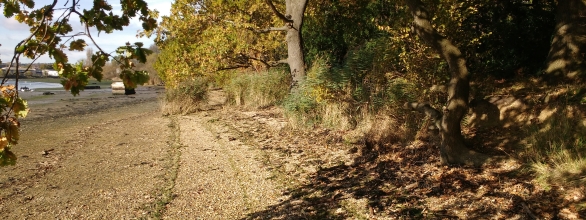Chessel Bay Local Nature Reserve

Chessel Bay Local Nature Reserve is situated on the eastern bank of the River Itchen, south of Northam Bridge. A variety of plants and animals can be seen here including wading birds such as curlews and oystercatchers, several species of seaweed, common shore crabs and purple flowering sea aster.
Chessel Bay is of great local importance, being the only remaining long stretch of natural shoreline in the lower reaches of the River Itchen. It also contains the only salt-marsh vegetation occurring within Southampton. A large proportion of the site is composed of mudflats and, at low tide, these provide major feeding grounds for wading birds and wildfowl.
What you can see
Birds are particularly numerous during the winter months and the site is also used as a stop-over point for other migrating birds such as common sandpiper and greenshank. The shoreline is made up of shingle with a marshy area running along the edge of the woodland. This is fringed with a variety of plants, common reed in particular, but also yellow iris and sea club-rush.
Plants and animals characteristic of coastal environments occur here as a result of the tidal influence. Common shore crabs can frequently be seen, and the purple flowers of sea asters can be seen from July onwards. Seaweeds found in the mud include the light green sea lettuce and the bladder wrack, which can tolerate fresh water.
A narrow strip of woodland runs along the edge of the reserve. Oak is the most abundant tree with some beech, crab apple and plum trees. A ground layer of bramble, holly and ivy provide dense cover for birds and small mammals along with winter heliotrope and cow wheat, which tends to be associated with long established woodlands.
Helping to care for Chessel Bay
If you visit Chessel Bay Local Nature Reserve (LNR), please keep to the footpath and the top of the shore to reduce disturbance and erosion. Avoid walking on the mudland, which is soft and potentially dangerous, as you may get trapped in the mud or caught by the incoming tide.
The mudflats are important feeding areas for birds that spend the winter months around the Solent. It is critical for the birds’ survival that they are able to feed uninterrupted, please don’t allow your dog to chase them.
Due to the geography of the bay, litter and waste is carried in on the wind and tide, however, we need to be careful with clean-ups because, if undertaken too frequently, they can damage habitats and disturb wildlife.
At the same time we accept that the litter being found on our foreshores is not acceptable and we are working with environmental groups and local businesses to improve the current situation.
Currently, two large scale clean-ups take place every year and are timed to avoid impacts on nesting and over-wintering birds. Details of the clean-ups are posted on the site noticeboard, on this webpage or information sent out by the friends group.
We politely request that groups do not litter-pick along the shoreline without first completing the following form:
Before you fill in this form
You won't be able to save this form to complete later, so please allow yourself at least five minutes to fill in the form.
Friends of Chessel Bay
There is an informal Friends of Chessel Bay group and website.
Email: chesselbayfriends@gmail.com
Website: www.chesselbay.org.uk

